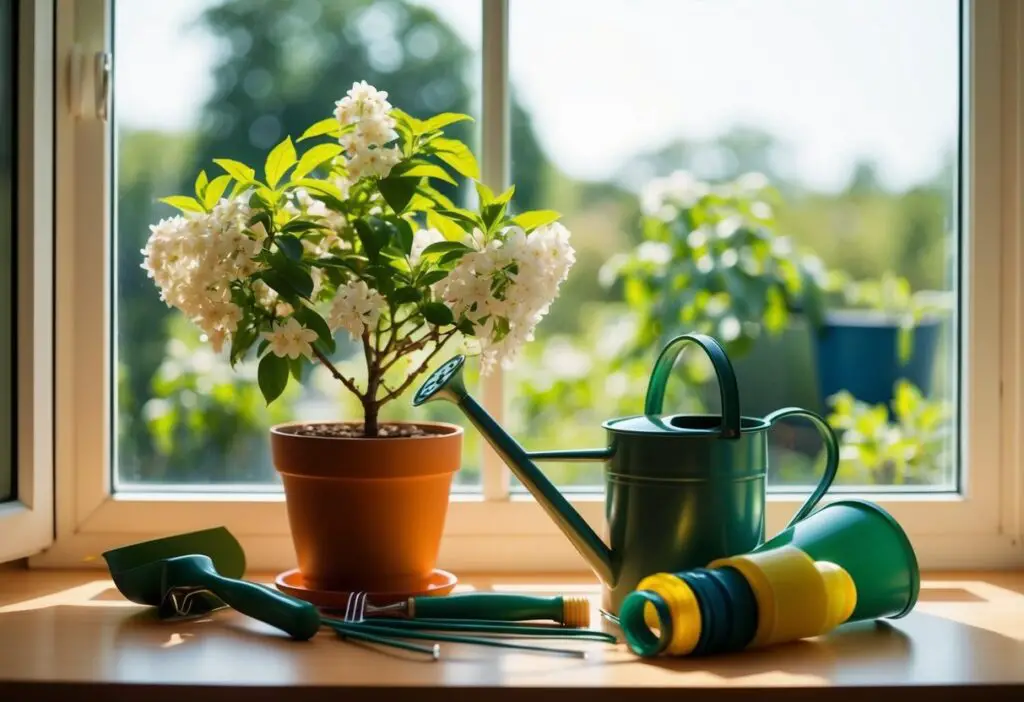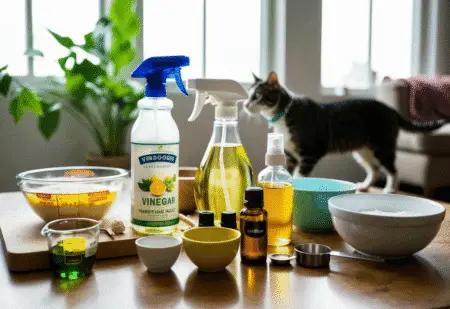Jasmine is well known for its sweet, floral fragrance found in teas, perfumes, and other products. Certain species like Jasminum sambac and Jasminum polyanthum are considered true jasmines.
These plants can grow as large shrubs or vines. You can also grow them indoors as houseplants.
Growing jasmine inside means paying attention to its needs, like light, watering, and care. Experts in gardening stress the value of proper techniques to help indoor jasmine thrive and keep its fragrant flowers blooming.
Table of Contents
Key Takeaways
- Proper light and watering are essential for healthy indoor jasmine.
- Different jasmine varieties can be grown inside with the right care.
- Understanding care routines helps prevent common growing problems.
The Best Indoor Jasmine Plant Varieties
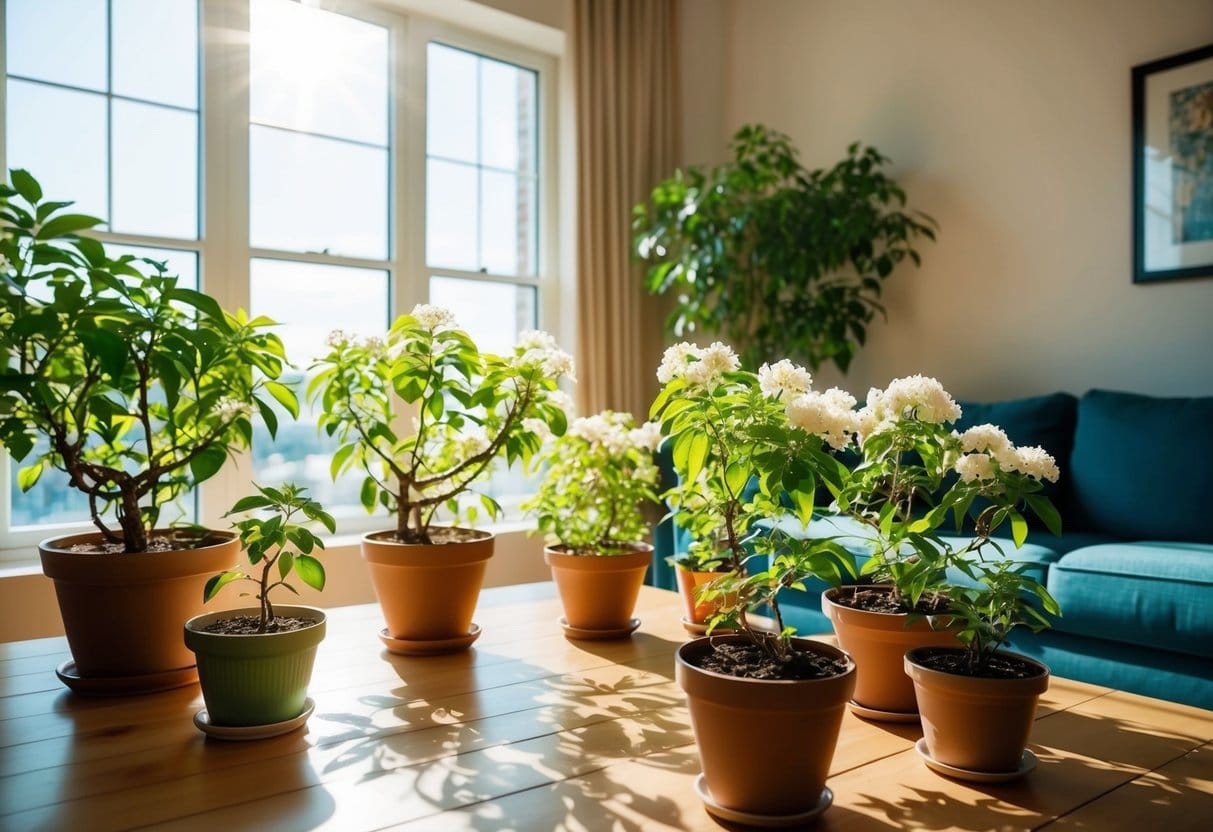
Arabian Jasmine (Jasminum Sambac)
Arabian Jasmine is famous for its strong fragrance. The Grand Duke of Tuscany variety is popular because it has double flowers and a rich scent.
This plant grows upright with stiff stems and needs regular trimming to stay manageable and bloom more. It likes warm, humid conditions and usually flowers in summer.
The Maid of Orleans cultivar also grows well indoors.
Pink Jasmine (Jasminum Polyanthum)
Pink Jasmine is a favorite for indoor gardeners because it flowers in winter. Its buds start pink and open into many white, star-shaped flowers with a sweet smell.
This type needs a cooler rest period to bloom, usually from late winter to early spring. It grows well on trellises or in hanging baskets, making it decorative indoors.
Its winter blooms can last from December to March.
Common Jasmine (Jasminum Grandiflorum)
Common Jasmine is known for its sweet fragrance and its ability to bloom several times a year. This type is semi-deciduous, dropping its leaves for a short time before new leaves and flowers grow back.
It adapts well to indoor conditions and provides a steady floral display with proper care.
| Variety Name | Flower Season | Growth Habit | Special Feature |
|---|---|---|---|
| Arabian Jasmine | Summer | Upright stems | Strong scent, needs pruning |
| Pink Jasmine | Winter (Dec-Mar) | Vining (trellis/hanging) | Star-shaped blooms, cool period needed |
| Common Jasmine | Year-round | Semi-deciduous shrub | Multiple bloom cycles |
How to Grow Jasmine Plants Indoors
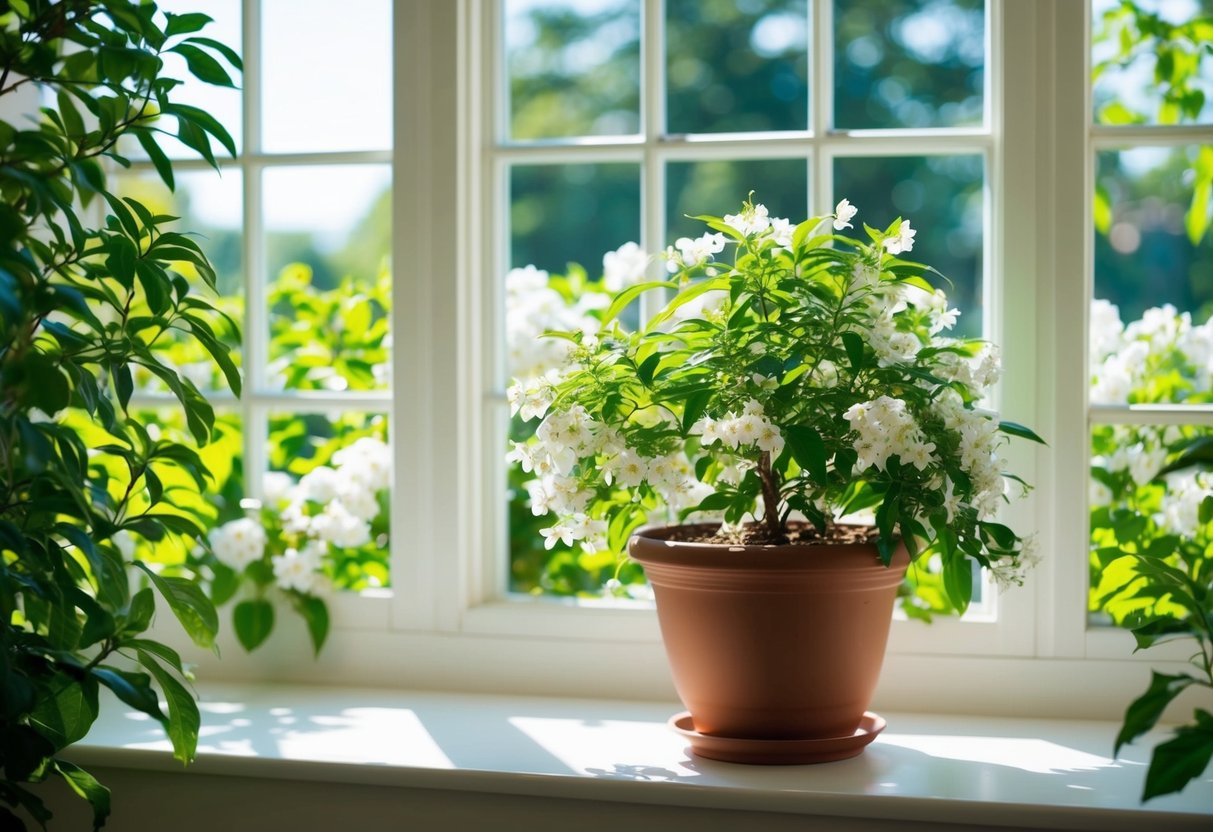
Light Needs for Jasmine
Jasmine plants need plenty of bright, indirect light. Aim for about six hours of strong, filtered light each day.
A spot near a window with filtered sun works well. Too much direct sun can burn the leaves.
Ideal Soil Conditions
Choose soil that drains well and is slightly acidic. Add good organic matter to keep the jasmine healthy.
Reduce feeding in winter since the plant grows more slowly then.
Watering Guidelines
Jasmine prefers soil that stays a little moist. In colder months, let the soil dry out a bit more between waterings.
Water about once a week. Make sure the pot drains well to avoid water buildup, which can cause root problems.
How to Care for Indoor Jasmine Plants
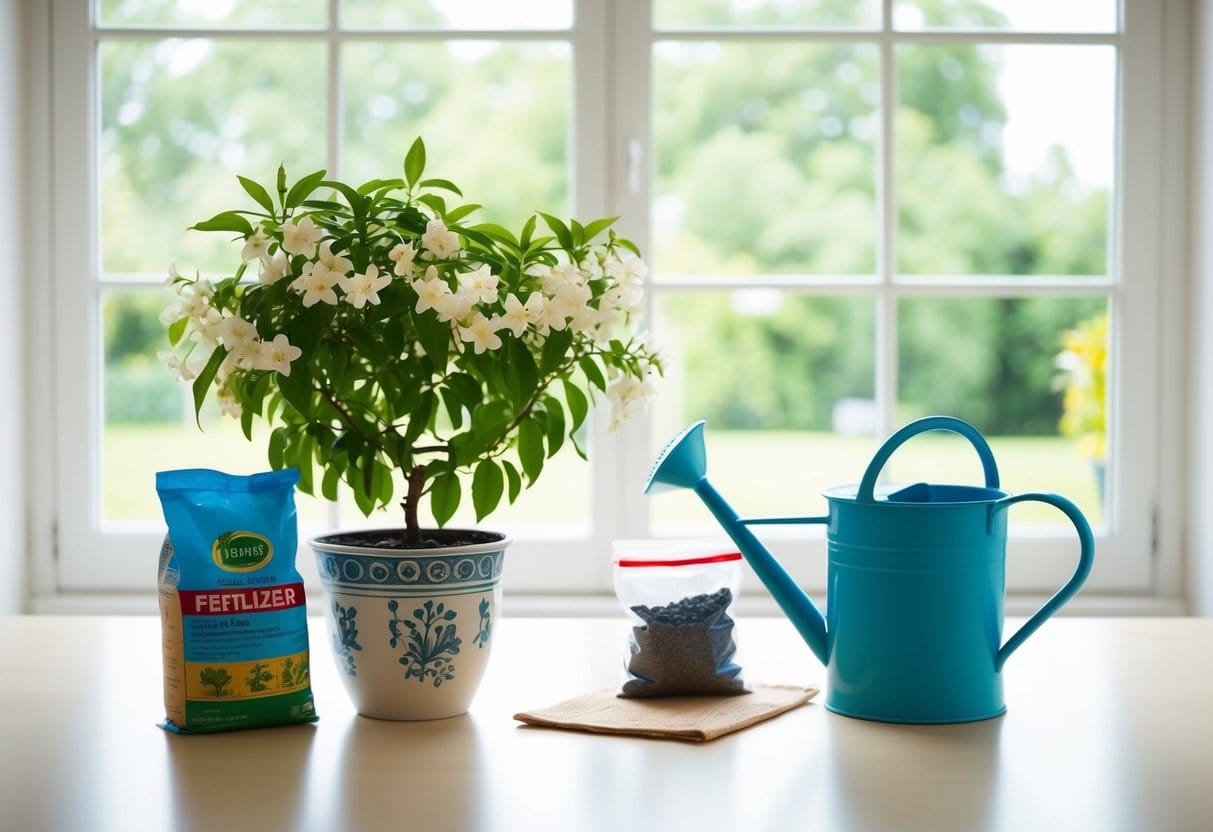
Managing Growth Through Cutting
Indoor jasmine plants grow quickly and need regular trimming to keep their shape and encourage flowering. Cut back the branches soon after blooming, about half an inch above a set of three to six leaves.
For bushier types like Jasminum sambac, prune in late spring and again in mid-summer to help more branches and flower buds develop. Stop trimming before fall to let the plant rest and form flower buds.
Feeding for Steady Growth
Use organic fertilizer every four to six weeks during the growing season, from spring through fall. Avoid over-fertilizing, as it can cause too much leaf growth and fewer flowers.
Do not fertilize during winter, when the plant rests and needs fewer nutrients. Keeping a moderate schedule for feeding and watering helps jasmine stay healthy and bloom well.
Guiding Climbing Jasmine
Vining jasmine plants, like Jasminum polyanthum, can be trained to grow along supports. Use a trellis to guide the vines upward.
Letting the plant hang from a basket also highlights its trailing stems and fragrant flowers. Proper training keeps the plant neat and encourages better blooming.
How to Refresh Your Indoor Jasmine Plant’s Pot

Repot jasmine in spring or early summer if the roots are crowded. If you see roots coming out of the pot bottom or soil surface, move the plant to a slightly larger pot, just one or two sizes bigger.
Use a potting mix that drains well. Gently loosen the root ball before placing the plant in the new pot to help the roots spread.
Press the soil firmly around the roots to prevent air pockets, then water thoroughly. Avoid repotting when flower buds are present, as this may cause the buds to fall off and delay blooming.
Steps to Multiply Jasmine Plants
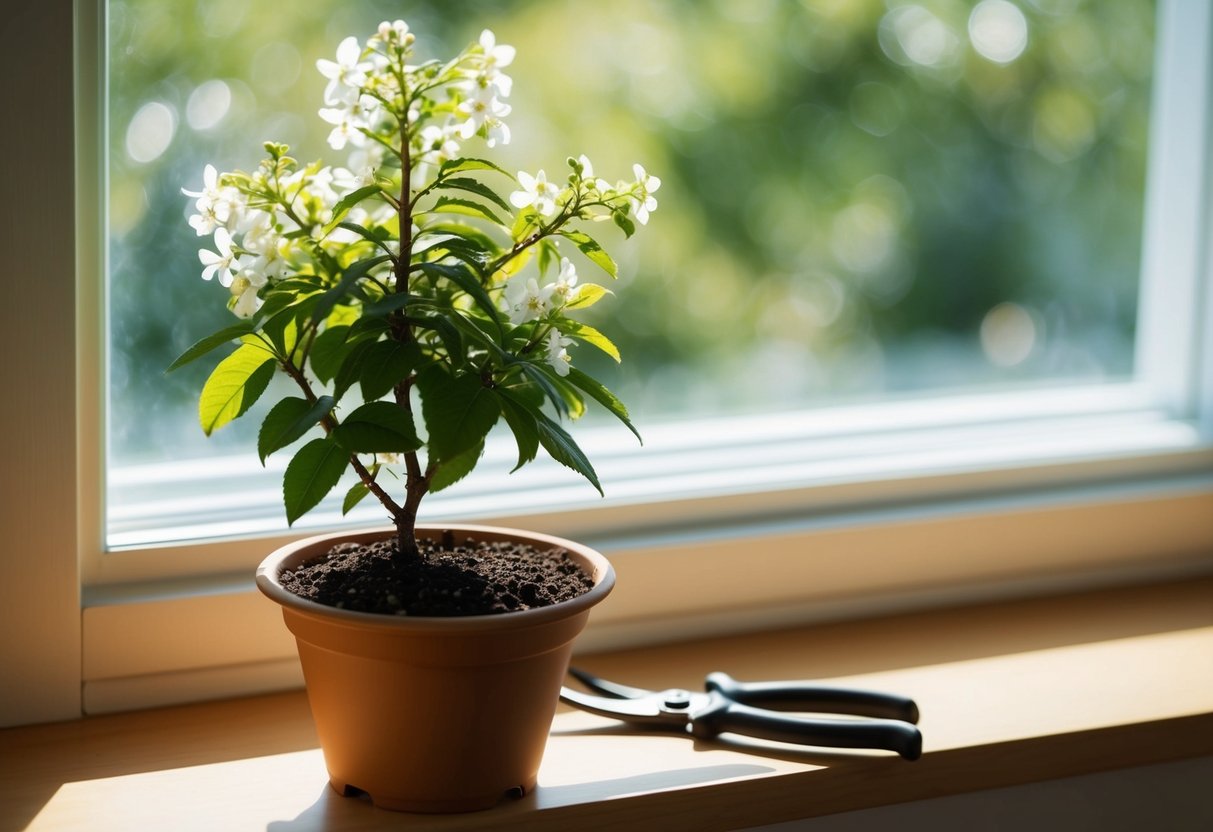
Use new growth when taking cuttings. Cuttings should be about 3 to 4 inches long for the best results.
Rooting jasmine takes time, usually more than four weeks.
- Plant cuttings in loose, well-draining soil or Leca to help roots spread.
- Cover the cuttings with a plastic dome or bag to keep the soil moist.
- Keep them in partial shade, away from direct sunlight.
- Make sure cuttings are not crowded or touching the cover.
- Once roots appear, remove the cover and move the young plants to a warm spot with bright, indirect light.
These steps help jasmine cuttings form roots and grow strong before transplanting.
How to Gather Jasmine Flowers for Use
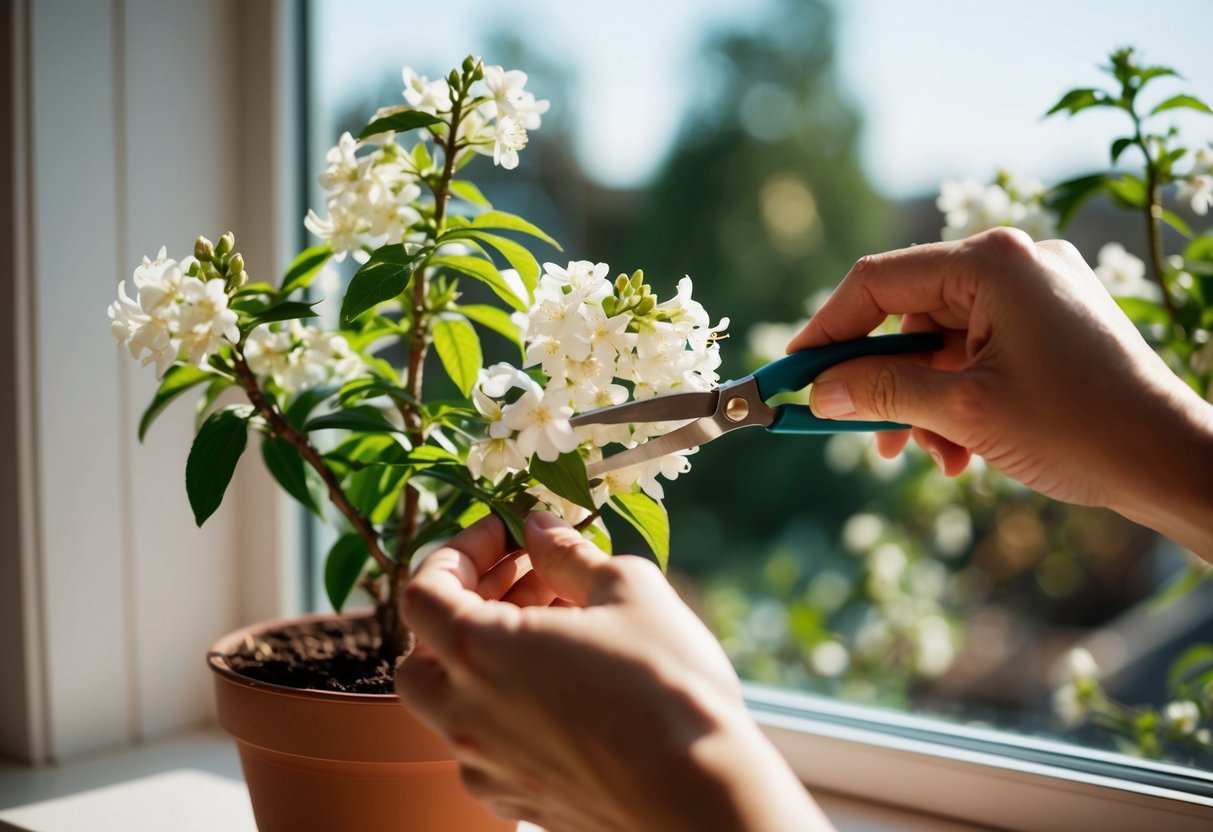
Before harvesting jasmine, make sure the plant is a true jasmine variety. Some look-alikes can be harmful if consumed.
Only true jasmines are safe for making jasmine tea or for edible uses. The best time to pick jasmine flowers is when the buds just begin to open.
This timing helps keep their fragrance and flavor. After picking, place the flowers in a cool, well-ventilated spot to dry them completely.
Once dried, add jasmine petals to tea leaves or infuse them into syrups and drinks. Harvesting flowers yourself lets you control growing conditions and avoid pesticides.
Tips for harvesting jasmine:
- Pick flowers early in the day for better scent.
- Do not remove too many flowers at once to keep the plant healthy.
- Dry flowers thoroughly in a breathable container or tray before use.
Typical Issues When Caring for Indoor Jasmine

Insect Problems
Indoor jasmine plants often attract pests like aphids, mealybugs, whiteflies, spider mites, and scale insects. Spider mites make fine webs on leaves and cause orange or brown spots.
These pests weaken the plant by feeding on its sap. Regularly use insecticidal soap or neem oil every two weeks to control infestations and keep the plant healthy.
Slow or Poor Development
Jasmine may grow slowly if air circulation is poor or the temperature is too warm or unstable, especially in winter. It grows best in cool, draft-free spaces.
Cooler temperatures help flower buds mature and encourage blooms. Keep the plant away from heat sources and cold drafts to support steady growth.
Leaf Problems
Leaf issues usually signal watering mistakes. Overwatering can cause root rot, making leaves drop easily.
Underwatering dries out leaves, causing them to lose shine and fall off. Powdery mildew or other fungal infections may appear if humidity is too high or airflow is low.
Place jasmine where you can monitor moisture and where air flows freely to prevent these problems.
| Problem Type | Cause | Sign | Solution |
|---|---|---|---|
| Pests | Aphids, mealybugs, spider mites | Webs, spots, sticky residue | Use insecticidal soap or neem |
| Slow Growth | Poor airflow, wrong temperature | Small leaves, no new buds | Keep cool, avoid drafts |
| Leaf Damage | Over/under watering, mildew | Dropping or dry leaves, discoloration | Adjust watering, improve airflow |
Frequently Asked Questions
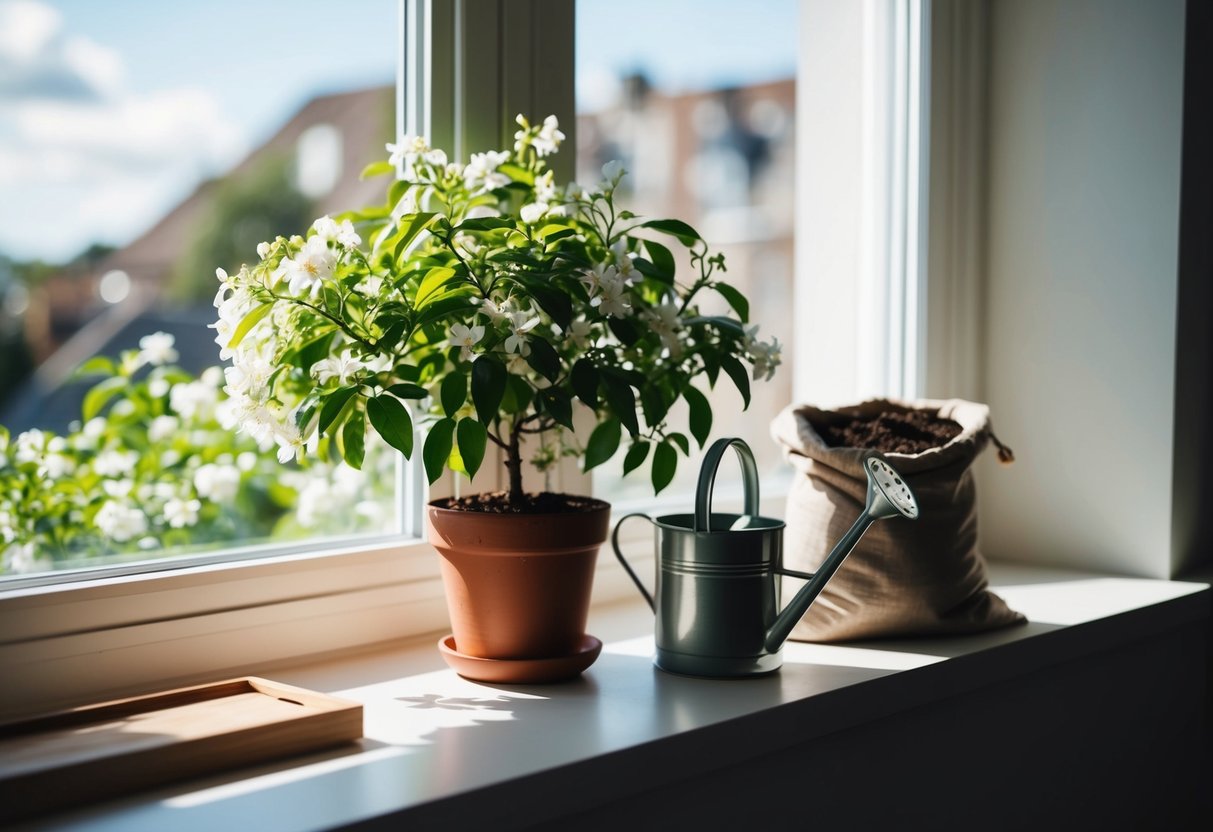
What conditions help jasmine thrive indoors?
Jasmine grows best in bright, indirect sunlight for about 6 hours daily. It prefers cool temperatures, especially in winter, around 50 to 55 degrees Fahrenheit.
Avoid placing jasmine in drafty or overly warm spots. Good ventilation helps the plant stay healthy.
How can indoor jasmine bloom more effectively?
Jasmine needs plenty of light without harsh direct sun to encourage flowering. Cooler temperatures during winter help trigger blooms.
Fertilize with a balanced plant food during the growing season to support flower production.
How often is watering needed for indoor jasmine?
Jasmine likes consistently moist soil but not soggy. Water when the top inch of soil feels dry.
Do not let the soil dry out completely or stay waterlogged, as both can harm the plant.
What is the proper way to trim indoor jasmine?
Prune after the blooming period. Cut back long, leggy stems to encourage bushier growth.
Remove dead or weak branches to keep the plant healthy. Shape the plant as you like.
What causes signs of poor health in indoor jasmine plants?
Yellow leaves, wilting, or lack of blooms may mean the plant gets too much or too little water, not enough light, or temperature stress. Pests or root problems can also cause issues.
Which jasmine types are best for growing inside homes?
Common Jasmine varieties for indoors include Jasminum polyanthum and Jasminum sambac.
These types adapt well to indoor light and temperature, so many people choose them as houseplants.
For more growing tips, visit How to Grow and Care for an Indoor Jasmine Plant.


